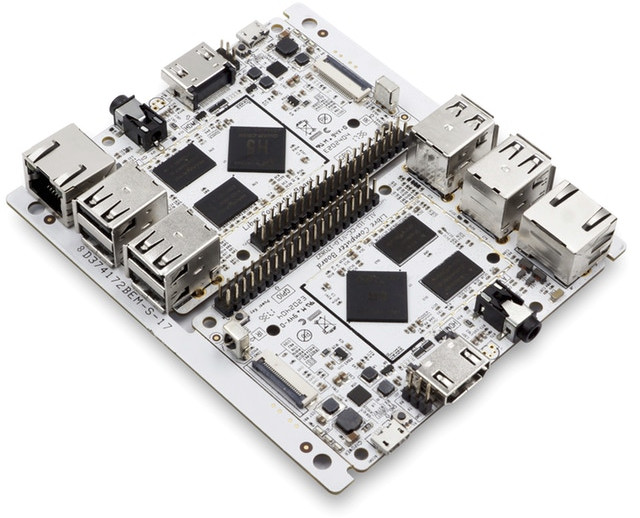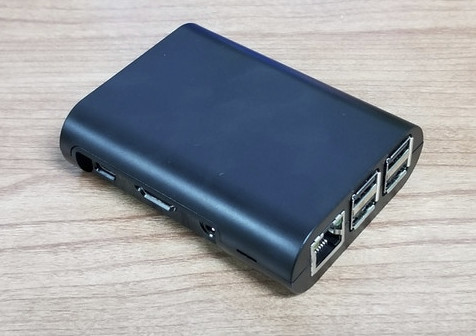A few months ago, Libre Computer introduced Le Potato board (aka AML-S905X-CC) powered by Amlogic S905X processor plus up to 2GB RAM, and using Raspberry Pi 3 form factor.
The company is now back with three Tritium boards, using the same form factor, but instead powered by Allwinner H2+, H3, or H5 processors, with a lower price point as the Tritium IoT board (H2+ / 512 MB RAM) goes for $9 only.

Tritium boards (ALL-H3-CC) specifications:
- SoC and Memory
- Tritium IoT – Allwinner H2+ quad core Cortex A7 processor with Mali-400MP2, 512MB DDR3
- Tritium 1GB – Allwinner H3 quad core Cortex A7 processor with Mali-400MP2, 1GB DDR3
- Tritium 2GB – Allwinner H5 quad core Cortex A53 processor with Mali-450MP4, 2GB DDR3
- Storage – 1x micro SD Card slot, eMMC module connector
- Video & Audio Output
- Tritium IoT – HDMI up to 1080p60, AV port
- Tritium 1GB & 2GB – HDMI 1.4 up to 4K30, AV port
- Camera – Parallel camera interface
- Connectivity – 10/100M Ethernet
- USB – 4x USB 2.0 host ports
- Expansion – 40-pin Raspberry Pi header with I2C, SPI, PWM, UART, 5V, 3.3V, and GPIO
- Debugging – UART via header for access to the serial console
- Misc – IR Receiver, u-boot button
- Power Supply – 5V via micro USB port
- Dimensions – Raspberry Pi 3 form factor
The boards do not perform as fast as the Amlogic S905X one, and the I2S and S/PDIF header are gone, but a camera connector has been added to connect a camera. Tritium IoT board runs Linux only (e.g. Ubuntu 16.04), but Tritium 1GB can run also Android 7.0, and Tritium 2GB Android 7.1, beside the listed Linux distributions:
- Ubuntu 16.04 by Libre Computer Project
- Debian 9 Stretch by Libre Computer Project
- Ubuntu 16.04 by Armbian
The Linux source will be released on Github as they’ve done for Le Potato, for which they’ve also released the PDF schematics, and CE/FCC certifications.

The project has been launched on Kickstarter with a $10,000 goal. The bare boards are available for respectively $9 (IoT), $19 (1GB), and $29 (2GB), but you can also get kits with all accessories such as the $59 “Tritium IoT Kit Special” with comes with:
- Tritium IoT Board
- 8GB eMMC 4.x Module
- Push-Pin Heatsink with Thermal Tape
- 5.1V/2.5A MicroUSB Power Supply
- Active Cooling Media Center Polycarbonate Case
- 1m HDMI Cable
- 8GB MicrorSD Card
- Wireless RF Remote with Mini Keyboard and Touchpad
Shipping is not included and depends on the selected reward, but for example it adds $7 to $9 to Tritium IoT board, and $10 to $14 to the kit listed above. Delivery is planned for January 2018, and general availability (outside the KS campaign) in February 2018. Hardware customizations are accepted for orders of 500 units or more.
The market is starting to get crowded with Allwinner H development boards thanks to the Orange Pi and NanoPi board families, but that also means software support should be good, and AFAIK, Tritium boards are the first to be compatible (HW + Mech) to Raspberry Pi 3, excluding NanoPi Duo + mini Shield which does not come with HDMI, and is limited to Allwinner H2+ with 512MB RAM. That means you could reuse or purchase RPi 3 accessories and they should work either out of the box (enclosures), or with some SW development efforts (add-on boards). RPi MIPI camera and display modules won’t work.

Jean-Luc started CNX Software in 2010 as a part-time endeavor, before quitting his job as a software engineering manager, and starting to write daily news, and reviews full time later in 2011.
Support CNX Software! Donate via cryptocurrencies, become a Patron on Patreon, or purchase goods on Amazon or Aliexpress




Sadly they crippled their design by limiting these devices to 20th century network speed, while all the CPUs involved are gigabit-enabled. I don’t know how long it will take for some board vendors to realize that they immediately sacrify a wide number of applications by doing so.
For the same price, a NanoPI NEO Plus2 adds Gigabit, 8GB eMMC, WiFi and Bluetooth. It’s fine to aim at RPi compatibility to add extra devices, but less such devices are needed when boards come better equipped. So no, thanks 🙂
Exactly the same thoughts here! They the heck do they strip GbE. And the USB ports must be behind an internal hub?
@willy
So are they going to have Android 7 on a H3 ?
” but Tritium 1GB can run also Android 7.0, and ”
Tritium 1GB – Allwinner H3 quad core Cortex A7 processor with Mali-400MP2, 1GB DDR3
fossxplorer : And the USB ports must be behind an internal hub? No, Allwinner H2+, H3 and H5 have 4 real USB2 host ports (4 EHCI/OHCI controller pairs, usually the Micro USB port on these boards is routed to an OTG controller but that can be switched to the 4th host controller. But on this board Micro USB is only used for DC-IN — which I consider the only real design flaw — and all 4 USB host ports are available as own receptacles that do not have to share bandwidth). It’s the same as on aforementioned NanoPi NEO Plus2… Read more »
@fossxplorer
There’s OTG on the H3 and H5 that can be used as an USB.
@willy
Neo Plus 2 is a 16-bit DDR design. It doesn’t have HDMI and only has 1GB of DRAM so it’s not exactly apples to apples.
@willy Well, H2+ is said to not contain the internal Gigabit Ethernet MAC (which I don’t believe, I would think it’s just Allwinner’s Android checking chip ID or something like that and then refusing to use GbE with their Android). Anyway: the above design allows for one PCB with three different SoCs and obviously they focus more on media and IoT applications than network. To me the $9 variant looks most appealing if it’s available for this price also later and we can buy in volume. Also not having to pay for useless crap Wi-Fi (the 2.4Ghz only 1T1R joke… Read more »
@tkaiser
I’d like to see someone make a ‘power hat’ which takes a more proper DC input connector with a DC/DC buck converter (so that it can be powered by laptop 19.5V supplies) and provides 5V to the board.
If these are using an Rpi header pinout, then a generic power hat should work on them as well.
@willmore
The cheap 5V microUSB power supplies sold for these boards are OK for hobbyist but will often fail after a few months when run 24/7. MTBF is non-existent which is really a warning — not for production use.
You’ll spend more on overnight shipping to replace the failed units for irate customers than the cost of the unit. Just one example of how cheap costs more in the long run.
@tkaiser: Is it expected that this option will be implemented in mainline kernel by default? As today I’ve made apt-get upgrade on my orange pi one (only one full USB port) and this option was again reverted to “otg” which made devices not working. Thanks.
@jqpabc123
Which is why I’d like to see a more proper solution using a laptop style 24/7 rated supply…….
@Suren Zadurian
That’s how it’s supposed to be. To change it you would need a DT overlay: https://docs.armbian.com/User-Guide_Allwinner_overlays/
A shame they don’t have a board+emmc+heatsink combo only. Most people don’t need the psu and case anymore…
I hope they will switch during the campaign to Gbe and indeed the option to power the board through some headers.
tkaiser : @willy Well, H2+ is said to not contain the internal Gigabit Ethernet MAC (which I don’t believe, I would think it’s just Allwinner’s Android checking chip ID or something like that and then refusing to use GbE with their Android). I don’t believe in this either, I’m pretty sure I’ve seen a few boards featuring H2+ with GbE out there, maybe one of the Banana Pi. I even think it was one of the differences with the H2. Anyway: the above design allows for one PCB with three different SoCs and obviously they focus more on media and… Read more »
9$ Shipping : no, thanks.
@matc
they add 9USD shipping to anywhere in the world, looks suspicious to me.
willy : I’m pretty sure I’ve seen a few boards featuring H2+ with GbE out there, maybe one of the Banana Pi I’ve not seen a single H2+ with GbE though BPi folks claim ‘allwinner H2+ chip H3 chip and H5 chip is PIN to PIN compatibility, so BPI-M2+ just replace H2+ ,H5 chip onboard, easy to DIY new product.just main chip is different, other spec is same as BPI-M2+ with allwinner H3 design’ — no idea whether they tried it out and H2+ with external RGMII attached RTL8211E works or not (since using H2+ internal Fast Ethernet PHY is… Read more »
I’ve not seen a single H2+ with GbE though BPi folks claim ‘allwinner H2+ chip H3 chip and H5 chip is PIN to PIN compatibility, so BPI-M2+ just replace H2+ ,H5 chip onboard, easy to DIY new product.just main chip is different, other spec is same as BPI-M2+ with allwinner H3 design’ — no idea whether they tried it out and H2+ with external RGMII attached RTL8211E works or not (since using H2+ internal Fast Ethernet PHY is impossible without rerouting the board). Apparently it’s indeed the BPi-M2+ which claims gigabit, I’ve found it on two links here indicating use… Read more »
Video on Libre Computing over at Armdevices by Charbax
http://armdevices.net/2018/06/05/libre-computer-development-boards-s905x-rk3328-h2-h3-h5-form-factor-compatible-with-raspberry-pi/